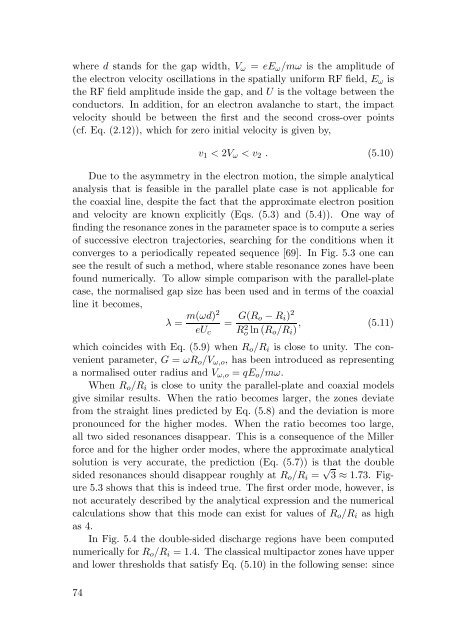Multipactor in Low Pressure Gas and in ... - of Richard Udiljak
Multipactor in Low Pressure Gas and in ... - of Richard Udiljak
Multipactor in Low Pressure Gas and in ... - of Richard Udiljak
Create successful ePaper yourself
Turn your PDF publications into a flip-book with our unique Google optimized e-Paper software.
where d st<strong>and</strong>s for the gap width, Vω = eEω/mω is the amplitude <strong>of</strong><br />
the electron velocity oscillations <strong>in</strong> the spatially uniform RF field, Eω is<br />
the RF field amplitude <strong>in</strong>side the gap, <strong>and</strong> U is the voltage between the<br />
conductors. In addition, for an electron avalanche to start, the impact<br />
velocity should be between the first <strong>and</strong> the second cross-over po<strong>in</strong>ts<br />
(cf. Eq. (2.12)), which for zero <strong>in</strong>itial velocity is given by,<br />
v1 < 2Vω < v2 . (5.10)<br />
Due to the asymmetry <strong>in</strong> the electron motion, the simple analytical<br />
analysis that is feasible <strong>in</strong> the parallel plate case is not applicable for<br />
the coaxial l<strong>in</strong>e, despite the fact that the approximate electron position<br />
<strong>and</strong> velocity are known explicitly (Eqs. (5.3) <strong>and</strong> (5.4)). One way <strong>of</strong><br />
f<strong>in</strong>d<strong>in</strong>g the resonance zones <strong>in</strong> the parameter space is to compute a series<br />
<strong>of</strong> successive electron trajectories, search<strong>in</strong>g for the conditions when it<br />
converges to a periodically repeated sequence [69]. In Fig. 5.3 one can<br />
see the result <strong>of</strong> such a method, where stable resonance zones have been<br />
found numerically. To allow simple comparison with the parallel-plate<br />
case, the normalised gap size has been used <strong>and</strong> <strong>in</strong> terms <strong>of</strong> the coaxial<br />
l<strong>in</strong>e it becomes,<br />
λ = m(ωd)2<br />
eUc<br />
= G(Ro − Ri) 2<br />
R2 , (5.11)<br />
o ln (Ro/Ri)<br />
which co<strong>in</strong>cides with Eq. (5.9) when Ro/Ri is close to unity. The convenient<br />
parameter, G = ωRo/Vω,o, has been <strong>in</strong>troduced as represent<strong>in</strong>g<br />
a normalised outer radius <strong>and</strong> Vω,o = qEo/mω.<br />
When Ro/Ri is close to unity the parallel-plate <strong>and</strong> coaxial models<br />
give similar results. When the ratio becomes larger, the zones deviate<br />
from the straight l<strong>in</strong>es predicted by Eq. (5.8) <strong>and</strong> the deviation is more<br />
pronounced for the higher modes. When the ratio becomes too large,<br />
all two sided resonances disappear. This is a consequence <strong>of</strong> the Miller<br />
force <strong>and</strong> for the higher order modes, where the approximate analytical<br />
solution is very accurate, the prediction (Eq. (5.7)) is that the double<br />
sided resonances should disappear roughly at Ro/Ri = √ 3 ≈ 1.73. Figure<br />
5.3 shows that this is <strong>in</strong>deed true. The first order mode, however, is<br />
not accurately described by the analytical expression <strong>and</strong> the numerical<br />
calculations show that this mode can exist for values <strong>of</strong> Ro/Ri as high<br />
as 4.<br />
In Fig. 5.4 the double-sided discharge regions have been computed<br />
numerically for Ro/Ri = 1.4. The classical multipactor zones have upper<br />
<strong>and</strong> lower thresholds that satisfy Eq. (5.10) <strong>in</strong> the follow<strong>in</strong>g sense: s<strong>in</strong>ce<br />
74


